Family name: Melanthiaceae Batsch ex Borkh.
Synonym(s): Chionographidaceae Takht.; Heloniadaceae J. Agardh; Paridaceae Dumort.; Trilliaceae Chevall., nom. cons.; Veratraceae Salisb.; Xerophyllaceae Takht.
Common name(s): death camas family
*Number of genera/species: 17/172
List of genera records in GRIN-Global
fruit or seed
Fruit a septicidal or loculicidalloculicidal:
type of capsular dehiscence, opening longitudinally through the locules (compare septicidal)
 capsulecapsule:
capsulecapsule:
a dry, dehiscent fruit derived from a compound ovary , folliclefollicle:
, folliclefollicle:
a dry to (rarely) fleshy fruit derived from a single carpel that opens along a single longitudinal suture, derived from a single, superior, simple ovary; the seeds may be arillate or with a fleshy testa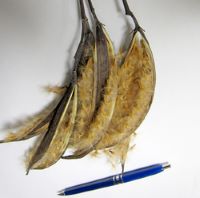 (aggregateaggregate:
(aggregateaggregate:
fruit formed from a single flower with carpels several and distinct ), or berryberry:
), or berryberry:
an indehiscent, fleshy fruit with one or a few to many seeds. The flesh may be homogenous throughout. Or, if the outer part is hard, firm, or leathery, referred to as an hesperidium. Septa are present in some, and the seeds may be arillate or with a fleshy testa.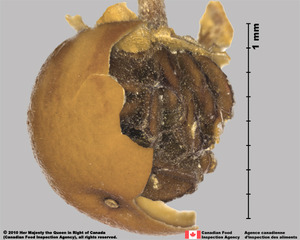 (Kinugasa, Paris, Pseudotrillium, Trillidium, Trillium spp.), 5–50 mm long, globoseglobose:
(Kinugasa, Paris, Pseudotrillium, Trillidium, Trillium spp.), 5–50 mm long, globoseglobose:
3D shape—more or less spherical to oblongoblong:
to oblongoblong:
2D shape—much longer than broad with nearly parallel sides, corners are rounded , often 3-lobed, sometimes stylestyle:
, often 3-lobed, sometimes stylestyle:
in a flower, the narrow and elongated part of the pistil between the stigma and the ovary; sometimes persisting in fruit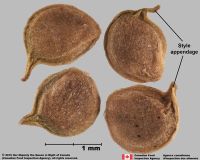 persistent, sometimes beaked, with few to many seeds. Pericarppericarp:
persistent, sometimes beaked, with few to many seeds. Pericarppericarp:
fruit wall or fruit coat
black, purple, green, red, or white, fleshy or membranousmembranous:
texture—extremely thin, pliable, and fairly tough
, smooth, ribbedribbed:
surface relief—wide, prominent, linear ridges that are generally rounded and longitudinally situated on the surface , ridgedridged:
, ridgedridged:
surface relief—raised, thick ridges, sharp edged or rounded, usually in a series that may cover the entire surface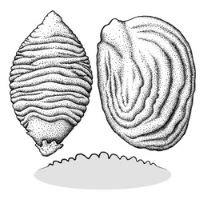 , groovedgrooved:
, groovedgrooved:
surface relief—linear depressions that may be single or form a series of grooves over the surface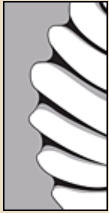 , or wartywarty:
, or wartywarty:
surface relief—distinct, rounded projections that are large relative to the fruit size; tuberculate, verrucose , sometimes pubescentpubescent:
, sometimes pubescentpubescent:
surface relief—bearing hairs
.
Seeds angularangular:
2D shape—having sides that meet at acute or obtuse angles
to oblongoblong:
2D shape—much longer than broad with nearly parallel sides, corners are rounded , tereteterete:
, tereteterete:
approximately circular in cross section; width and thickness approximately equal
 or flattened in transection, 1.8–15 mm long, usually winged or with terminal appendages. Seeds winged at one end (Chionographis), with wing surrounding seed (Chamaelirum, Melanthium, Veratrum), or with long caudatecaudate:
or flattened in transection, 1.8–15 mm long, usually winged or with terminal appendages. Seeds winged at one end (Chionographis), with wing surrounding seed (Chamaelirum, Melanthium, Veratrum), or with long caudatecaudate:
tapering to a long, tail-like appendage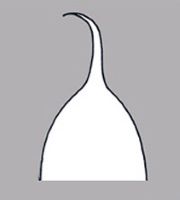 appendages present at both ends (Helonias, Heloniopsis, Ypsilandra). In Trillium, seeds with yellow or white elaiosomeselaiosome:
appendages present at both ends (Helonias, Heloniopsis, Ypsilandra). In Trillium, seeds with yellow or white elaiosomeselaiosome:
a lipid and protein-rich fleshy structure attached to some seeds and fruits, it attracts ants which then disperse the disseminule (e.g., caruncle in the Euphorbiaceae, the aril (outgrowth of the funiculus) in the Fabaceae)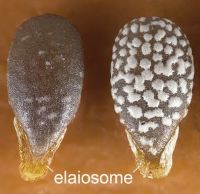 or strophiolesstrophiole:
or strophiolesstrophiole:
appendage or outgrowth of seed coat near the hilum and micropyle
that enclose most or all of the seed. Seed coat black, brown, purple, or green (with a red, fleshy sarcotestasarcotesta:
pulpy or fleshy outer layer of the seed coat, simulates aril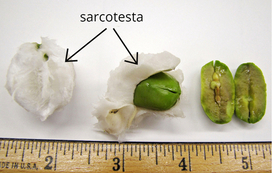 in Daiswa), shinyshiny:
in Daiswa), shinyshiny:
uniformly reflecting a high proportion of incident light at all angles , smooth or reticulatereticulate:
, smooth or reticulatereticulate:
surface relief—netted, raised walls or concave grooves forming a net-like surface pattern with flat, concave, or convex interspaces .
.
Embryo usually minute, globoseglobose:
3D shape—more or less spherical to ovoidovoid:
to ovoidovoid:
3D shape—ovate , basalbasal:
, basalbasal:
at or pertaining to the point of attachment; (of embryo) embryo occupies one end of the seed
or large in some species of Melanthium and Ziagadenus, linearlinear:
(shape) long, narrow, and uniform in width; (of embryo) embryo is straight and much longer than wide and axialaxial:
and axialaxial:
(of embryo) embryo is situated along the longitudinal axis of the seed and may partially or completely fill the seed
.
Endosperm copious.
| Fruit | |
| Type | capsulecapsule: a dry, dehiscent fruit derived from a compound ovary  , berryberry: , berryberry:an indehiscent, fleshy fruit with one or a few to many seeds. The flesh may be homogenous throughout. Or, if the outer part is hard, firm, or leathery, referred to as an hesperidium. Septa are present in some, and the seeds may be arillate or with a fleshy testa.  , folliclefollicle: , folliclefollicle:a dry to (rarely) fleshy fruit derived from a single carpel that opens along a single longitudinal suture, derived from a single, superior, simple ovary; the seeds may be arillate or with a fleshy testa  |
| Size range | 5–50 mm long |
| Shape(s) | ovoidovoid: 3D shape—ovate  , oblongoblong: , oblongoblong:2D shape—much longer than broad with nearly parallel sides, corners are rounded  , ellipsoidellipsoid: , ellipsoidellipsoid:3D shape—elliptic , globoseglobose: 3D shape—more or less spherical  |
| Texture | fleshy or membranousmembranous: texture—extremely thin, pliable, and fairly tough |
| Surface relief | smooth or ribbedribbed: surface relief—wide, prominent, linear ridges that are generally rounded and longitudinally situated on the surface  , ridgedridged: , ridgedridged:surface relief—raised, thick ridges, sharp edged or rounded, usually in a series that may cover the entire surface  , groovedgrooved: , groovedgrooved:surface relief—linear depressions that may be single or form a series of grooves over the surface  or wartywarty: or wartywarty:surface relief—distinct, rounded projections that are large relative to the fruit size; tuberculate, verrucose  |
| Color(s) | black, purple, green, red, white |
| Unique features | Membranousmembranous: texture—extremely thin, pliable, and fairly tough capsulescapsule: a dry, dehiscent fruit derived from a compound ovary  often with winged or terminally appendaged seeds. Or, fleshy berriesberry: often with winged or terminally appendaged seeds. Or, fleshy berriesberry:an indehiscent, fleshy fruit with one or a few to many seeds. The flesh may be homogenous throughout. Or, if the outer part is hard, firm, or leathery, referred to as an hesperidium. Septa are present in some, and the seeds may be arillate or with a fleshy testa.  with smooth or reticulatereticulate: with smooth or reticulatereticulate:surface relief—netted, raised walls or concave grooves forming a net-like surface pattern with flat, concave, or convex interspaces  seeds, sometimes with bright red, fleshy seed coats or elaisomes. seeds, sometimes with bright red, fleshy seed coats or elaisomes. |
| Seed | |
| Size range | 1.8–15 mm long |
| Shape(s) | oblongoblong: 2D shape—much longer than broad with nearly parallel sides, corners are rounded  , lanceoloidlanceoloid: , lanceoloidlanceoloid:3D shape—lanceolate , fusiformfusiform: spindle-shaped; broadest at the middle and tapering at both ends 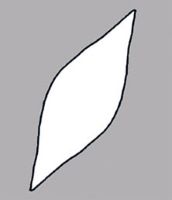 , ellipsoidellipsoid: , ellipsoidellipsoid:3D shape—elliptic , conicalconical: 3D shape—cone-shaped, with the point of attachment at the broad end 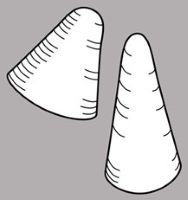 , polygonalpolygonal: , polygonalpolygonal:angular |
| Surface relief | smooth, reticulatereticulate: surface relief—netted, raised walls or concave grooves forming a net-like surface pattern with flat, concave, or convex interspaces  |
| Color(s) | black, brown, purple, green |
| Unique features | Winged or terminally appendaged seeds, usually with small, basalbasal: at or pertaining to the point of attachment; (of embryo) embryo occupies one end of the seed embryos. Red, fleshy coated seeds in Daiswa. Or, seeds with yellow or white elaisomes that enclose most of the seed in Trillium. |
| Other | |
| Embryo | usually minute, globoseglobose: 3D shape—more or less spherical  to ovoidovoid: to ovoidovoid:3D shape—ovate  , basalbasal: , basalbasal:at or pertaining to the point of attachment; (of embryo) embryo occupies one end of the seed or large in some species of Melanthium and Ziagadenus, linearlinear: (shape) long, narrow, and uniform in width; (of embryo) embryo is straight and much longer than wide  and axialaxial: and axialaxial:(of embryo) embryo is situated along the longitudinal axis of the seed and may partially or completely fill the seed |
| Nutritive tissue | endosperm copious |
North temperate regions, with one genus extending from southern North America to Peru.
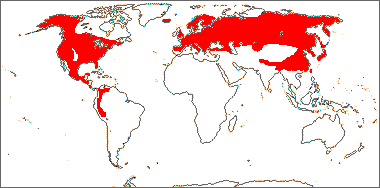
Distribution map courtesy of Angiosperm Phylogeny Website.
Baskin and Baskin 2021Baskin and Baskin 2021:
Baskin C and Baskin J. 2021. Relationship of the lateral embryo (in grasses) to other monocot embryos: A status up-grade. Seed Science Research 31 (3): 199-210. doi:10.1017/S0960258521000209; Dahlgren et al. 1985Dahlgren et al. 1985:
Dahlgren RMT, Clifford HT, and Yeo PF. 1985. The families of the monocotyledons: structure, evolution, and taxonomy. Springer-Verlag, Berlin. 520 pp.; Flora of North America Editorial Committee 1993+Flora of North America Editorial Committee 1993+:
Flora of North America Editorial Committee, eds. 1993+. Flora of North America North of Mexico [Online]. 22+ vols. Flora of North America Association, New York and Oxford. Accessed January-March 2024. URL: http://beta.floranorthamerica.org.; Kirkbride et al. 2006Kirkbride et al. 2006:
Kirkbride JH, Jr, Gunn CR, and Dallwitz MJ. 2006. Family guide for fruits and seeds, vers. 1.0. Accessed September 2020-January 2022. URL: https://nt.ars-grin.gov/seedsfruits/keys/frsdfam/index.cfm .; Kubitzki et al. 1990+Kubitzki et al. 1990+:
Kubitzki K et al., eds. 1990+. The families and genera of vascular plants. 7+ vols. Berlin etc.; Stevenson and Loconte 1995Stevenson and Loconte 1995:
Stevenson DW and Loconte H. 1995. A cladistic analysis of monocot families. In: Rudall PJ, Cribb PJ, Cutler DF, and Humphries CJ, eds. Monocotyledons: Systematics and Evolution. Royal Botanic Gardens, Kew.; Takhtajan 2009Takhtajan 2009:
Takhtajan A. 2009. Flowering plants: Second edition. Springer Nature, Switzerland. 871 pp.; Tutin et al. 1964–1980Tutin et al. 1964–1980:
Tutin TG, Burges NA, Chater AO, Edmondson JR, Heywood VH, Moore DM, Valentine DH, Walters SM, and Webb DA (eds.) 1964–1980. Flora Europaea. 5 vols. Cambridge University Press, Cambridge UK. 2,524 pp.; Zhengyi et al. 2004+Zhengyi et al. 2004+:
Zhengyi W, Raven PH, and Deyuan H. 2004+. Flora of China [online]. 25 vols. Science Press, Beijing China & Missouri Botanical Garden, St. Louis USA. Accessed January–March 2024. http://flora.huh.harvard.edu/china/
*The number of genera and species is based on Christenhusz and Byng 2016Christenhusz and Byng 2016:
Christenhusz MJM and Byng JW. 2016. The number of known plant species in the world and its annual increase. Phytotaxa 261 (3): 201-217. https://doi.org/10.11646/phytotaxa.261.3.1, which may differ from the number of genera in GRIN-Global.